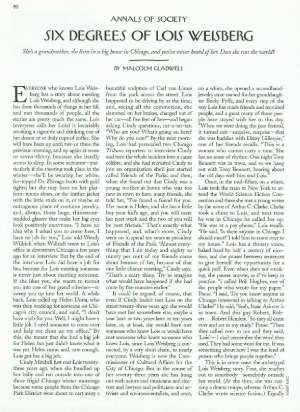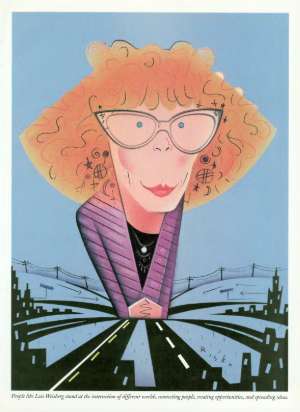The New Yorker, January 11, 1999 P. 52
ANNALS OF SOCIETY about Lois Weisberg. The writer describes stories about how people first meet Lois Weisberg, Chicago's Commissioner of Cultural Affairs. Cindy Mitchell first met Lois by chance 23 years ago and that meeting led to her job as president of Friends of the Park. The writer contends that Weisberg is connected, by a very short chain, to nearly everyone. In the course of her 73 years she has become acquainted with a wide variety of people from all different walks of life. The writer describes how Lois met sci-fi writer Arthur C. Clarke in the mid-'50s. The writer wonders whether people like Lois--who have a kind of undefined social power--actually make the world work by spreading ideas and information, and by connecting varied and isolated parts of society. The writer describes how, in the mid-'80s, Lois quit her job to hang out with a group of itinerant peddlers who ran the city's flea markets. He tells about the time a Chinese student named Shi Young stayed at Lois's home and Young reported what he saw there to a large Chinese newspaper. The writer describes an experiment conducted in the late '60s by Stanley Milgram which established the concept of six degrees of separation. In this experiment, Milgram found that a very small number of people are linked to everyone else in a few steps, and the rest of us are linked to the world through those few. The writer uses his own circle of friends to illustrate this point. The writer also uses the parlor game Six Degrees of Kevin Bacon to explain this phenomenon. The goal of this game is to link different actors to Bacon in fewer than 6 steps. UVA computer scientist Brett Tjaden recently calculated the average degree of connectedness for each of the quarter million or so actors listed in the Internet Movie Database. The top 15 includes Burgess Meredith. The writer describes Meredith's career and credits his high degree of connectedness with his wide range. Thus, Meredith and Weisberg's range--the fact that they belong to lots of different worlds--is key to their connection to a great many people. Weisberg was the daughter of a prominent attorney, and, in the '50s, after working in the theatre, she started an underground alternative weekly called the "Paper"; the writer describes the paper's weekly editorial meetings, attended by people like Lenny Bruce--who actually stayed with Lois for a while. After Lois's first marriage broke up, she began doing P.R. work, and, in the process, she founded 2 civic organizations--the Friends of the Parks and the South Shore Recreation (railroad preservation). She became the executive director of the Chicago Council of Lawyers, ran Congressman Sidney Yates's reelection campaign, and got a job working for Mayor Harold Washington. The writer believes that Lois has belonged to nearly 20 different worlds in her lifetime. Ironically, she was also friends with Burgess Meredith. The writer describes attending a breakfast meeting between Lois and Mayor Daley. In 1990, Lois started a successful arts program for poor and middle-class kids in Chicago called Gallery 37. The writer claims that Lois's influence suggests that there is power in relationships that aren't close. Sociologist Mark Granovetter examined the importance of "weak ties" in his classic 1974 book "Getting a Job," in which he found that most people obtained their jobs through acquaintances, not close friends. Granovetter emphasized the importance of knowing someone like Lois who knows many people--because then you're just one "chain length" away from a good opportunity. Granovetter's findings suggest that what matters in getting ahead is not the quality of your relationships but the quantity. The writer mentions a friend of his named Roger Horchow, who, like Lois, seems to know everybody. The writer claims that people like Roger and Lois have an innate and involuntary affinity for people. The writer describes how Lois met her 2nd husband, Bernie Weisberg, at a party for Ralph Ellison. The writer claims that Lois isn't bound by the same boundaries that defeat the rest of us, and that the secret to her connections is that "she likes lots of people." The writer ends by describing a reception he attended at the Museum of Contemporary Art with Lois.


